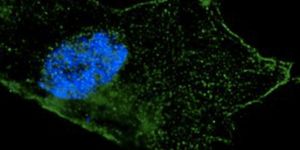Viruses Can Create New Genes By Stealing Bits of Human DNA
When viruses infect cells, they hijack the machinery inside and start to use it for their own purposes. This enables viruses to generate more viral particles that can exit the cell and spread the virus to even more cells. Scientists have now found that when some viruses, including pathogens like influenza, get inside of cells, they can also snatch pieces of the host cell genome, and use this genetic material to enhance its own genome and create new proteins. The findings have been reported by an international team of researchers in Cell.
Viruses are often classified by the type of genome they carry (as explained in the video below). This work focused on segmented negative-strand RNA viruses (sNSVs), which include viruses that cause influenza and Lassa fever. The study showed that they are capable of stealing DNA and creating many different kinds of proteins, which were hybrids of viral and human sequences, which the scientists called UFOs (Upstream Frankenstein Open reading frames). The proteins they generate could be affecting infection and could be useful in the design of vaccines.
"The capacity of a pathogen to overcome host barriers and establish infection is based on the expression of pathogen-derived proteins," said the corresponding study author Ivan Marazzi, Ph.D., Associate Professor of Microbiology at Icahn School of Medicine. "To understand how a pathogen antagonizes the host and establishes infection, we need to have a clear understanding of what proteins a pathogen encodes, how they function, and the manner in which they contribute to virulence."
When viruses manipulate a host cell's machinery to create viral proteins, they use a process called 'cap-snatching,' which cuts off the end of a piece of host mRNA (molecules that represent the protein-coding sequence of a gene) and then extends it with viral gene sequence, creating a gene hybrid.
"For decades we thought that by the time the body encounters the signal to start translating that message into protein (a 'start codon') it is reading a message provided to it solely by the virus. Our work shows that the host sequence is not silent," explained Dr. Marazzi.
The hybrid genes made by sNSVs can initiate the translation of the protein from mRNA at a new site, which is called 'start-snatching.' This can create totally new proteins, which can be expressed by influenza viruses and maybe many others as well. These proteins may not attract the attention of the immune system, and they may influence the severity of an infection. More work will be needed to understand their impact.
"Viruses take over their host at the molecular level, and this work identifies a new way in which some viruses can wring every last bit of potential out of the molecular machinery they are exploiting. While the work done here focusses on influenza viruses, it implies that a huge number of viral species can make previously unsuspected genes," noted the corresponding study author Ed Hutchinson, Ph.D., a research fellow at MRC-University of Glasgow Centre for Virus Research.
Discovering these novel proteins was only the first step. "Now we know they exist, we can study them and use the knowledge to help disease eradication," said Dr. Marazzi. "A large global effort is required to stop viral epidemics and pandemics, and these new insights may lead to identifying novel ways to stop infection."
Sources: AAAS/Eurekalert! Via The Mount Sinai Hospital/ Mount Sinai School of Medicine, Cell









